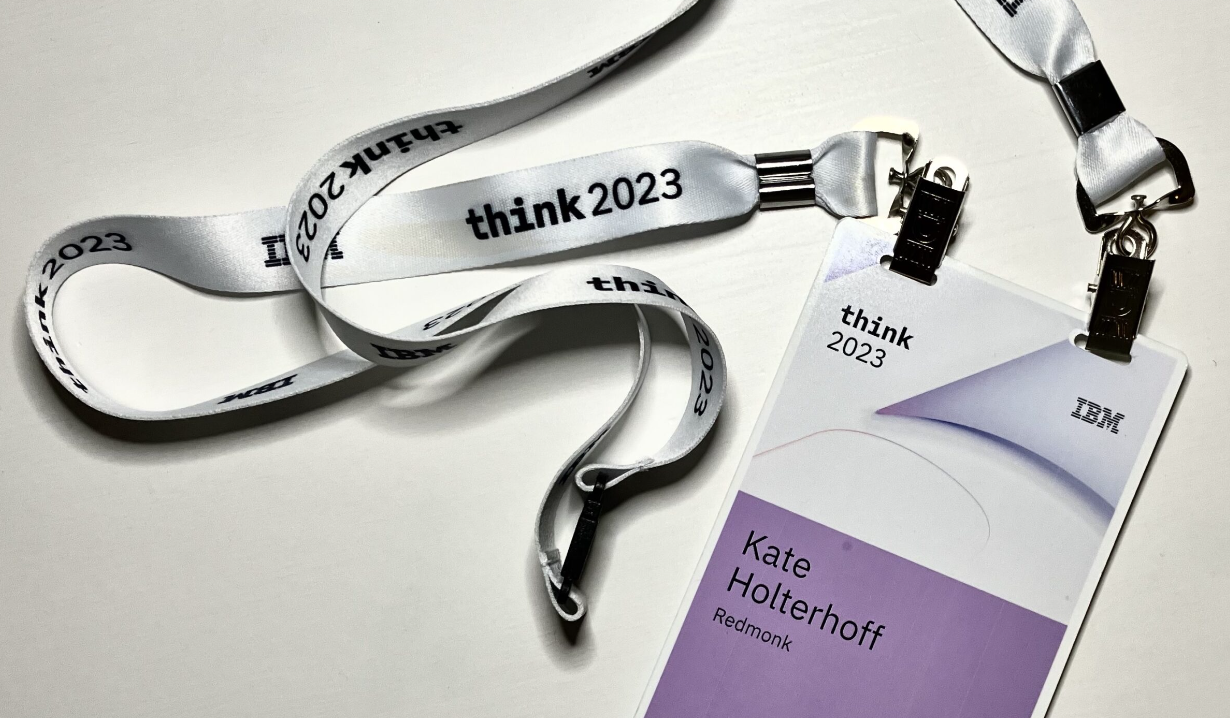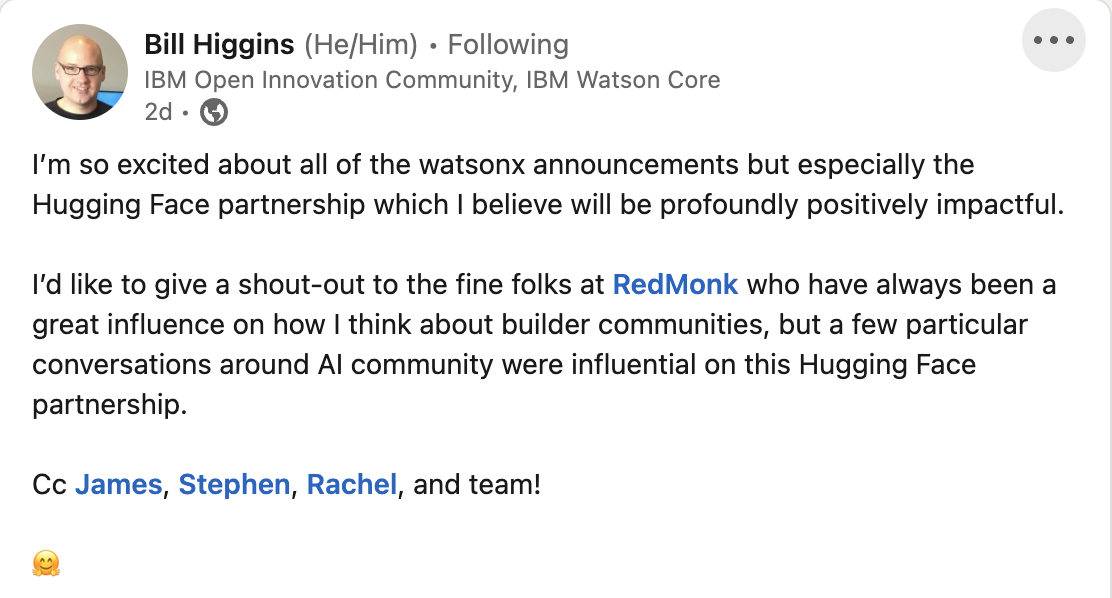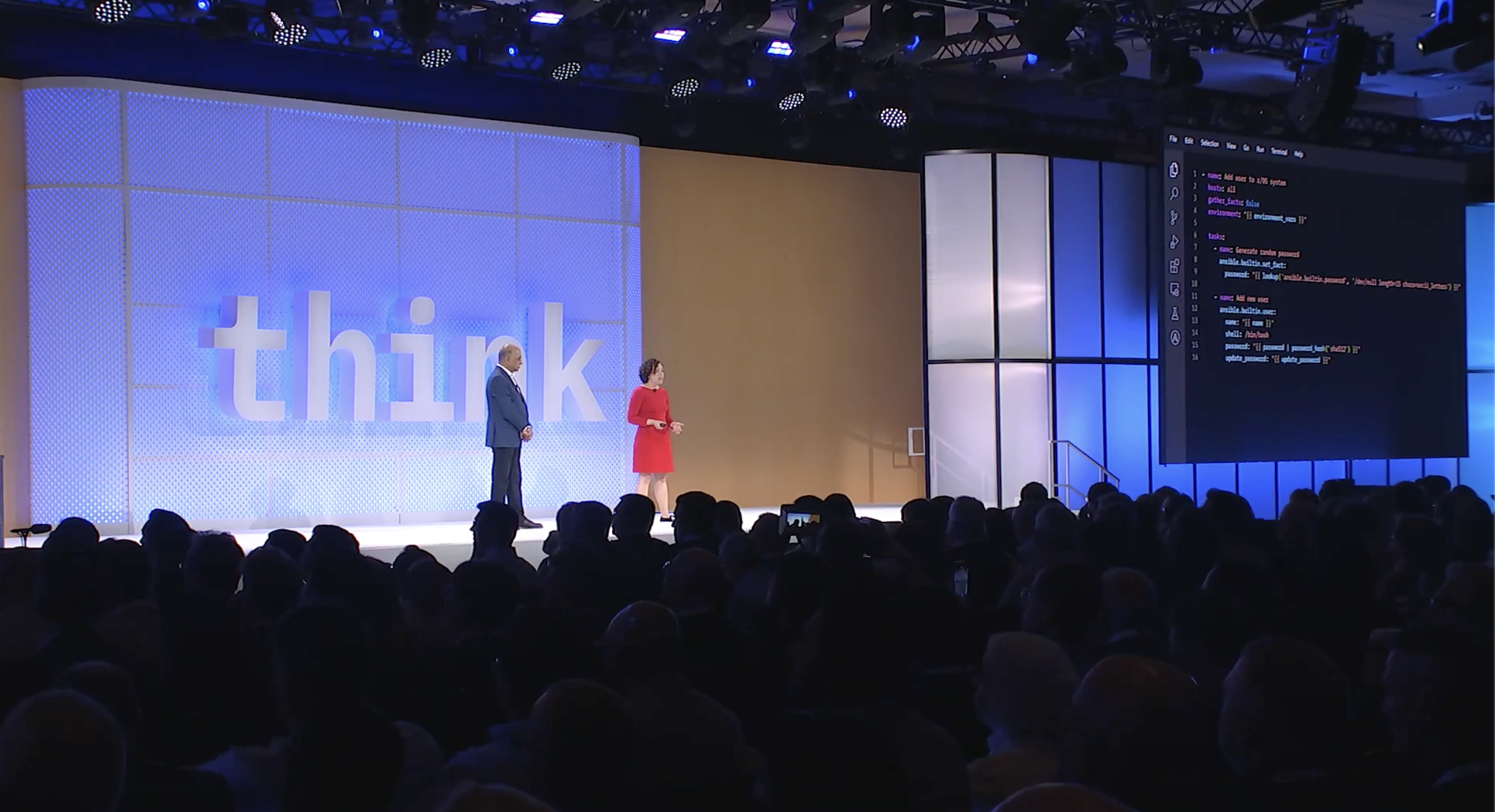Last week I attended IBM Think 2023 in Orlando. With conference season officially here, and the Covid-19 pandemic over (I guess??), I don’t anticipate having time to write up all the conferences I will be attending this month, but I wanted to riff on a few themes from Think because what I observed there is representative of some larger trends in the industry right now—particularly as they relate to AI.
Let’s talk about IBM. In many ways this technology company is an enigma. IBM is famously secretive. Their product portfolio is eye-wateringly diffuse. Moreover, determining what exactly it is that IBM does is becoming more and more challenging. In the 50s IBM’s mainframe computers dominated the market, closely associating the brand with hardware. This reputation helped drive IBM’s personal computer arm, and especially the popular ThinkPad during the 90s. But since offloading ThinkPad in 2005, IBM’s products and services have been more difficult to grok, even among industry experts. Today IBM makes money through its software products and its consultancy, and it is poised to make a splash with a bevy of new AI products. Or so the speakers at Think assured me.
IBM’s positioning in regards to AI tows the company line by remaining somewhat opaque, but it is a history that runs especially deep. IBM’s efforts in the AI space date back to the 50s, when:
IBMers such as Nathaniel Rochester, designer of the IBM ® 701, were investigating aspects of pattern recognition and artificial intelligence, the building blocks for speech recognition.
This background, if well known among history of computing buffs, lies beyond the interest of most consumers. However, even for folks that have somehow bypassed the overhyped news cycle concerning AI, even laypersons are aware of IBM’s 2011 PR coup in which Watson beat Ken Jennings and Brad Rudder on Jeopardy!
And yet the Jeopardy! victory seemed up until very recently to be the high point of the IBM AI story. Watson was always intended to support the healthcare industry, but when Watson Health failed to pan out, it ignominiously transitioned “From the Future of Health Care to Sold Off for Parts.” This perception of failure has been difficult for IBM to shake. However, IBM has been stalwart in upholding the Watson IP (remember the 2016 World of Watson conference?). In fact, leaning into the Watson brand seems to have been precisely IBM’s intent last week with the debut of watsonx, the “AI and data platform that’s built for business,” and its three components—watsonx.ai, watsonx.data, and watsonx.governance.

Everything AI, all the time
It is an understatement to say that AI took pride of place at this year’s Think: the event was everything AI, all the time. Arvind Krishna‘s opening keynote set the tone for the event. Although he lists hybrid cloud beside artificial intelligence as the two technologies that can “help transform and bring a lot of value,” the lion’s share of excitement was visibly reserved for AI.
And this enthusiasm for AI extended throughout every session I attended, as well as the forum’s demos and live experiences. Not one session failed to mention AI repeatedly. Meanwhile, the forum’s flashy and frequently interactive exhibits overwhelmingly highlighted how IBM’s products leverage AI to empower customers who manage IT infrastructure.
Attendees of landmark conferences have come to expect a certain whiz-bang factor, and at this year’s Think the “oohs” and “ahhs” were reserved almost exclusively for watsonx. It is worth pausing on the name watsonx, as it is somewhat controversial. I can understand why not everyone loves it, but I think “watsonx” accomplishes 2 things well. 1) It positions IBM as an established player on the AI front. Watson is an extremely recognizable IP; so much so that up until last year Watson was arguably the world’s most well known AI technology. 2) The extreme “x” suggests that this new iteration of Watson brings with it new, innovative contributions to the AI space. Although Elon Musk has sucked much of the air out of the room surrounding the letter “x” (see this recent NPR article for a history), adding the “x” suffix to Watson seems to me to offer an elegant solution to IBM’s rebranding strategy.

The monks have been watching IBM’s contribution to the AI space evolve in recent months. As the capabilities of LLMs (GPT-4, PALM, LLaMA) mature, there is ample opportunity to take advantage of the breakneck pace of innovation in the market. According to Samuel R. Bowman’s “Eight Things to Know about Large Language Models“:
There are few widely agreed-upon limits to what capabilities could emerge in future LLMs.
IBM seems uniquely positioned to leverage these new capabilities wherever they emerge, and this open and inclusive attitude will serve it well. In addition to IBM’s strategic partnerships, particularly with Hugging Face, watsonx is model agnostic. Instead of mandating the use of models trained by IBM, watsonx allows users to engage with the explosion of new models appearing every day. IBM’s multi-model approach to AI confronts the “moat” issue by demonstrating that watsonx’s value proposition lies in infrastructure, and therefore outside the layer of the stack at which models operate.
It’s interesting to see similarities in positioning between IBM and AWS at this juncture. With its recent announcements on AI, AWS has also been keen to stress the multi-model future. As my colleague James Governor has recently argued:
What multicloud was to the last 10 years, multi-model probably will be to the next ten. We’ve already seen AWS start positioning itself accordingly/. Multi sounds good when you’re not the market leader.
AWS is heir to the sort of market dominance that IBM exhibited last century. The adage that “IBM is not the competition, it is the environment in which you compete,” can now be said of AWS. How incumbents fare in times of great upheaval is of tremendous importance in the AI race, meaning that we will be following this strategy with interest. IBM has historically done tremendous packaging exercises (think System 360), but in the AI market the quick mover wins. IBM, like AWS, will need to keep pace with more agile startups and open source.
Open Source
The story of open source dovetails with that of AI (as does everything, because, you know, everything AI all the time), but in the case of IBM in particular these entwined narratives are especially tightly-knit.
Historically, IBM is the enterprise company which drove OSS into enterprise adoption. In fact, Red Hat situates IBM as a reasonably well-positioned contender in the space for leveraging OSS in AI (admittedly recent cuts, particularly on the Fedora team, have me worried). As Think attendees were often reminded, watsonx is built on Red Hat OpenShift.
OSS’s place in IBM’s AI strategy appeared repeatedly. For instance, as Damien Sereni, Engineering Director at Meta explains:
with the release of IBM watsonx, the PyTorch team at Meta and IBM are collaborating further to build a production-ready software stack for end-to-end training, fine-tuning and inference of large-scale foundation models.
While these partnerships and engagements with leading OSS projects represent a positive step, I left Think with many questions unresolved. To begin, conversations around AI need to go beyond just strategic partnerships to materially address AI’s social and environmental repercussions. Equally important, I question whether IBM is still positioned to drive enterprise adoption to open source.
Sustainability
RedMonk has covered IBM’s sustainability initiatives in the past (see Rachel Stephens’s excellent conversation with Michael Jacobs, Sustainability & Social Innovation Leader at IBM, about their Sustainability Accelerator). IBM is doing good work on this front, a necessary effort as the extraction and energy costs of AI are not inconsequential.
At Think I was able to speak with a number of folks about IBM’s sustainability initiatives. On the forum showroom, for instance, I heard about IBM’s carbon calculator, a tool intended to “Help Organizations Address Greenhouse Gas Emissions to Advance their Sustainability Objectives.” Observability dashboards like these will be necessary for ESG accountability efforts, particularly in the EU where regulators move faster than the US (*sigh*). In the hyped-up space of the forum, this calculator contributed a virtuous sheen of environmental stewardship to IBM’s brand, which is consistent with their recent environmental initiatives.
As an infrastructure company, IBM understands the true environmental impact of our AI-driven future better than most, so I sincerely hope their stated commitment to the environment goes beyond green washing. That said, AI was consistently treated as a net positive for the environment, and the carbon cost of this increased compute was never questioned in a substantive way.
Social Concerns
I did not witness tough conversations concerning the social cost of our AI future at Think. This represents a lost opportunity, particularly considering Krishna’s recent interview with Bloomberg announcing that roughly 7,800 positions could be lost at IBM as these roles are replaced by AI. He reflects:
I could easily see 30% of that getting replaced by AI and automation over a five-year period.
The timing of Krishna’s candid announcement was obviously intended to coincide with the debut of watsonx. It is no small claim that IBM plans to replace workers with AI. In fact Alex Kantrowitz credits this announcement as being representative of “The AI PR Industrial Complex“:
Instead of a company responding to a technological sea change, IBM feels more like a diminished giant using AI as a pretext to cut costs. Those close to the company say its statements — while giving it the AI sheen — mask the reality within, where the big, slow organization would struggle to hand thousands of jobs to AI. “Blanket statements work for people that don’t understand how technology can scale across the enterprise,” one ex-IBM employee told me. “It just completely gives more rationale to have more leeway to make more reductions.”
While this scathing assessment of Krishna’s plans to shift IBM’s current hiring practices may be overly harsh, the financial expediency of these cuts for IBM’s shareholders is terrifying to tech sector employees already anxious about their job security prospects. But I think the more significant work Krishna’s statement accomplished involves that of convincing the press that IBM has something relevant to say about AI. Krishna not only primed the pump for Think’s watsonx debut, it also reminded the public, which had become wrapped up in the rival offerings of Google’s Bard and OpenAI’s ChatGPT, of IBM’s leadership in this space.
Of course, concerns about labor and “The Great Reshuffle” are only the tip of the iceberg when it comes to AI. Beyond the more hyperbolic existential threats of humanity’s mass extinction, AI poses risks for security. While watsonx.governance is intended to meet this new breed of threats head-on, I think guest speaker Will.i.am actually tapped into the larger tenor of these concerns. Although he mainly spoke about the subject of AI’s use to replicate the “essence” of musicians and actors, Will.i.am points out that bad actors will attempt to commit fraud using generative AI to copy an individual’s appearance and voice. This is a disturbing proposition that IBM’s current portfolio of solutions does not address.
We partnered with @iamwill to develop the ultimate productivity tool, @FOCUSYOURIDEAS. Shared at #Think2023, the new collaboration brings IBM Consulting's expertise to the platform. Learn more about the venture: https://t.co/CfctV1FNXP pic.twitter.com/bcPLKjqqes
— IBM Consulting (@ibmconsulting) May 11, 2023
Where are the Devs?
The AI threads that IBM yanked on at Think are legion, so I’ll wrap up this post with a question: where are the devs?
Perhaps this is a stupid question, as Think is a conference targeted to the C-suite and does not purport to address developers. Fair enough. But if that is the case it is curious that Krishna welcomed Kaete Piccirilli, Director of Product Marketing at Red Hat, onto the stage during the opening keynote to demo Watson Code Assistant.
I was excited about what the foregrounding of Piccirilli’s demo seemed to suggest about the importance of developer experience. IBM’s answer to other AI assisted code tools like GitHub’s Copilot and AWS’s CodeWhisperer signals the importance of practitioners to the Watson brand, which received such a thorough makeover last week. There were even code blocks from a text editor on screen!
While including this demo in the CEO’s keynote projected a technical veneer onto the conversation surrounding IBM’s AI offerings, this early nod to developers turned out to be a one-off, and not representative of the rest of the conference. All of this leads me to wonder if devs will want to use Code Assistant when competitors in the space court them directly.

Beyond DevX, I will be interested to hear more about how all of IBM’s AI products (and Code Assistant in particular) are grappling with the legal concerns faced by its competitors. And I’m not the only monk worried about this. A recent post by Stephen O’Grady ties the issue of OSS to the legal uncertainties which have become the norm for conversations about AI:
Then there are the issues with the licenses, which range from open source to open(ish) to proprietary. Then there are the issues with the non-obvious dependencies on non- or less than open assets. Then there are the issues of who, precisely, is potentially at legal risk. Providers, potentially. Users of these systems? It seems unlikely, but as we are constantly reminded in the traditional open source world all it takes is one overly aggressive and litigious party to cast a pall over a given market.
I’ll leave my recap of Think and my musings on the subject of IBM’s overall AI strategy here. Did you attend Think? Opinions about IBM’s announcements are just beginning to roll in, so let me know if I omitted anything.
Disclaimer: IBM, Red Hat, Microsoft (GitHub), and AWS are RedMonk clients.
Header image credit: DALL-E2 and “Analysis of Speech advertisement: This IBM ad highlights the Speech Recognition Project at the IBM Yorktown Research Center.” From “Pioneering Speech Recognition.” https://www.ibm.com/ibm/history/ibm100/us/en/icons/speechreco/

No Comments